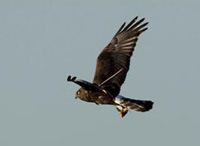Conservation of the Black Harrier in the Western Cape: tracking birds through land transformation and across landscapes
Research team: Andrew Jenkins & Rob Simmons

More recently harriers have been followed outside the breeding season using (Argos) satellite tracking technology. The results from five birds show impressive movements eastwards across the continent to Lesotho for the summer. One bird has recently (2011) returned to its west coast breeding grounds after a 2500 km journey in 5 months. Future research will include assessments of the influence of climate change on the frequency and success of breeding.
The Black Harrier project was largely funded by the Critical Ecosystem Partnership Fund (CEPF) and is part of the C.A.P.E. (Cape Action Plan for People and the Environment) initiative. More recently it has been supported by the NRF. The Black Harrier can be used as a conservation flagship and an indicator of habitat health because of its dependence on pristine patches of indigenous vegetation.
Find out more about the FitzPatrick Institute's Raptor Research Programme.
IMAGE: Black Harrier Circus maurus. Photo taken by Mark Anderson.
